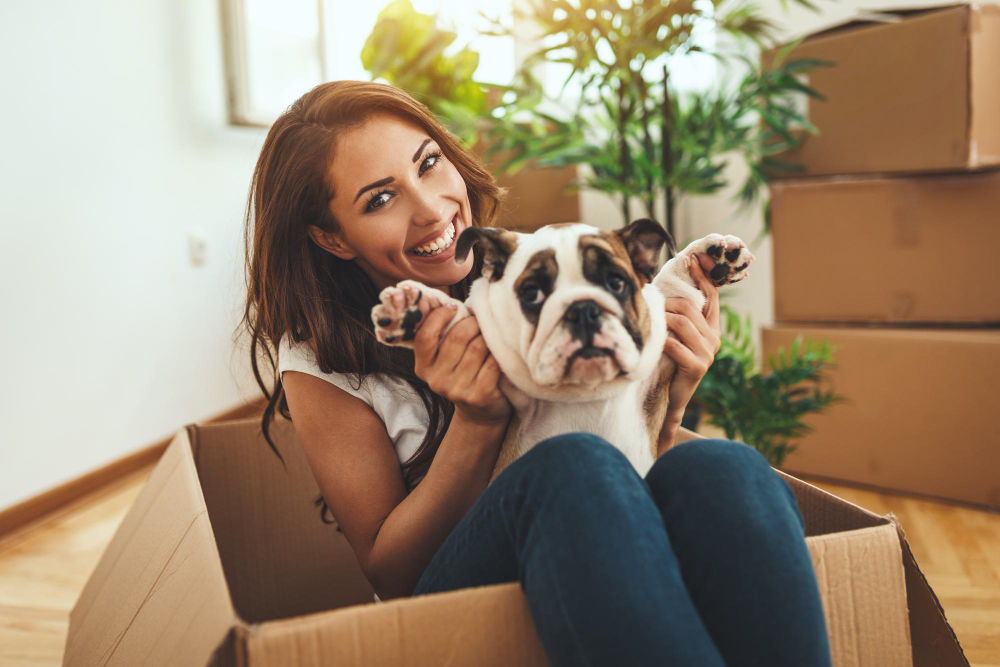

Moving to a new apartment can be just as stressful for your furry friend as it is for you. Between unfamiliar sounds, new smells, and a completely different layout, pets often struggle to adjust to apartment living. The good news? With the right approach, your pet can not only adapt but truly thrive in their new home.
Whether you're a first-time pet owner or a seasoned pro navigating apartment life, this guide will help you create a comfortable, safe, and enriching environment for your four-legged family member. From choosing the right space to establishing routines that work, we'll cover everything you need to know about successful apartment living with pets.
Your pet's size and energy level should guide your apartment selection. Large dogs need space to move around comfortably, while smaller pets can thrive in cozier quarters. However, don't overlook the importance of layout. An open floor plan gives pets more room to roam, while apartments with multiple rooms provide quiet spaces for rest and play areas for activity.
Consider your pet's daily routine when evaluating space. Cats need vertical territory—think tall cat trees and shelving—while dogs benefit from horizontal space for toys and movement. Even in smaller apartments, creative use of space can meet your pet's needs.
The surrounding area plays a huge role in your pet's quality of life. Look for apartments near parks, walking trails, or designated pet areas. Easy access to veterinary clinics and pet stores adds convenience to your routine.
Research local noise levels too. Apartments on busy streets might overwhelm noise-sensitive pets, while quieter neighborhoods provide a more peaceful environment. Some pets adapt well to urban energy, while others prefer suburban tranquility.
Modern apartment communities often include pet-specific amenities that can make a significant difference in your pet's happiness. Dog parks, pet washing stations, and designated pet relief areas eliminate common apartment living challenges.
Some communities offer pet sitting services or have partnerships with local veterinarians. These conveniences can save time and reduce stress for both you and your pet.
Pets feel more secure when they have designated spaces within your apartment. Set up a specific area for your pet's bed, food, and toys. This creates a sense of ownership and provides a safe retreat when your pet feels overwhelmed.
For cats, consider vertical spaces like cat trees or wall-mounted shelves. These give them elevated territory and help satisfy their natural climbing instincts. Dogs often prefer floor-level spaces where they can stretch out and observe their surroundings.
Apartments can be noisy environments with sounds from neighbors, hallways, and street traffic. Help your pet adjust by creating quiet zones within your space. Soft furnishings, rugs, and curtains can absorb sound and create a calmer atmosphere.
White noise machines or calming music can mask disruptive sounds during your pet's adjustment period. Some pets respond well to nature sounds or classical music designed specifically for animals.
Apartment living often means less control over temperature and natural light than single-family homes. Ensure your pet has access to both warm and cool spots throughout the day. Pet-safe heating pads or cooling mats can help regulate their comfort.
Maximize natural light by keeping curtains open during the day. If your apartment lacks sufficient natural light, consider full-spectrum bulbs that mimic sunlight, especially beneficial for pets that spend most of their time indoors.
Limited outdoor space doesn't mean limited exercise opportunities. Interactive toys, puzzle feeders, and treat-dispensing balls keep pets mentally engaged while providing physical activity. Rotate toys regularly to maintain interest and prevent boredom.
For dogs, consider indoor agility courses using household items or purchased equipment. Cats benefit from laser pointers, feather wands, and climbing structures that encourage natural hunting behaviors.
Make the most of outdoor time by exploring your neighborhood together. Regular walks help dogs burn energy and provide mental stimulation through new sights and smells. Even short outdoor sessions can significantly impact your pet's well-being.
For cats comfortable with harnesses, supervised outdoor time can provide enrichment while keeping them safe. Start with brief sessions and gradually increase duration as your cat becomes more comfortable.
Pets thrive on predictable schedules, especially during transitions. Establish regular feeding times, exercise periods, and play sessions. Consistency helps reduce anxiety and creates structure in your pet's day.
Morning and evening routines become anchors in your pet's schedule. Even brief activities like morning stretches or evening grooming sessions provide stability and bonding opportunities.
Building positive relationships with neighbors benefits everyone, especially when pets are involved. Introduce yourself and your pet to nearby residents. Address any concerns proactively and be responsive to feedback about noise or behavior issues.
Consider your pet's impact on shared spaces. Clean up after your pet immediately, keep noise levels reasonable, and ensure your pet doesn't disturb others in hallways or common areas.
Apartment living can limit your pet's exposure to other animals and people. Seek out socialization opportunities through pet-friendly events, training classes, or playdates with other pet owners in your building.
Dog parks and pet-friendly businesses provide controlled social environments where your pet can interact with others. These experiences are crucial for maintaining social skills and preventing isolation.
Apartment living presents unique safety challenges. Secure balconies with pet-safe barriers, especially for cats who might attempt to climb railings. Check for gaps or openings where small pets might become trapped.
Keep toxic plants, chemicals, and small objects out of reach. Apartment maintenance might require temporary access to your unit, so ensure your pet's safety plan includes secure confinement when necessary.
Develop an emergency plan that includes your pet. Keep carriers, leashes, and important documents easily accessible. Know your building's evacuation procedures and how they accommodate pets.
Maintain relationships with nearby pet-friendly hotels or boarding facilities in case of displacement. Having a plan reduces stress during unexpected situations.
Successful apartment living with pets requires intentional daily routines. Morning activities might include feeding, brief exercise, and mental stimulation before you leave for work. Evening routines can focus on longer play sessions and bonding time.
Adjust routines based on your pet's natural rhythms. Some pets are more active in the morning, while others prefer evening activities. Work with your pet's preferences rather than against them.
Every pet adjusts to apartment living differently. Some adapt quickly, while others need weeks or months to feel completely comfortable. Be patient during the transition period and celebrate small victories.
Monitor your pet's behavior for signs of stress or anxiety. Changes in appetite, sleep patterns, or activity levels might indicate adjustment challenges. Consult with your veterinarian if concerns persist.
Moving to an apartment with your pet requires preparation and patience. Start by visiting your new space together before move-in day if possible. This helps your pet begin adjusting to new sights and smells gradually.
Pack your pet's essentials in an easily accessible box so you can set up their space immediately upon arrival. Having familiar items available reduces stress during the transition period.
Consider the timing of your move. Avoid peak stress periods in your pet's life, such as after illness or during seasonal changes that might already challenge their comfort levels.
Apartment living with pets can be incredibly rewarding when approached thoughtfully. The key lies in understanding your pet's needs, preparing your space appropriately, and maintaining consistent routines that support their well-being.
Success comes from viewing your apartment through your pet's eyes. What might seem like limitations can become opportunities for creativity and bonding. The closer quarters often lead to stronger relationships between pets and their owners.
If you're looking for apartments in Wilson, NC, contact Oasis at Heritage today to schedule a personal tour. Their pet-friendly community offers the amenities and environment your furry friend needs to thrive in their new home.